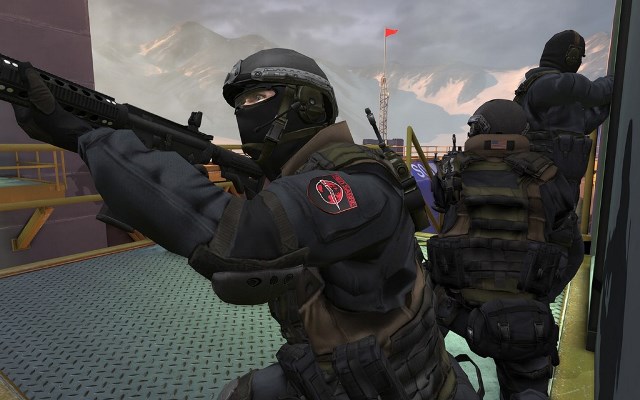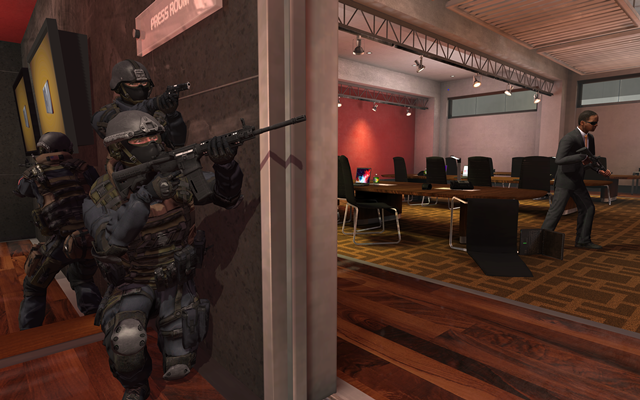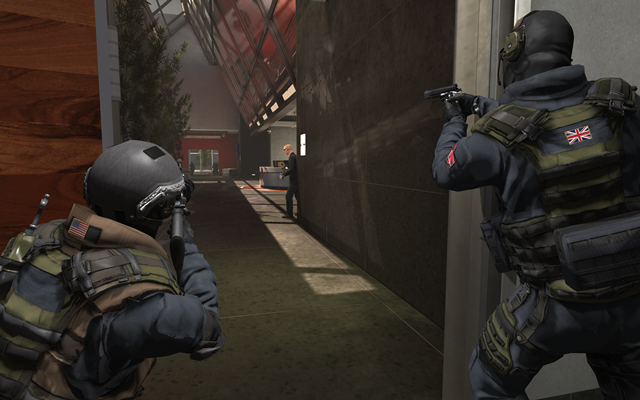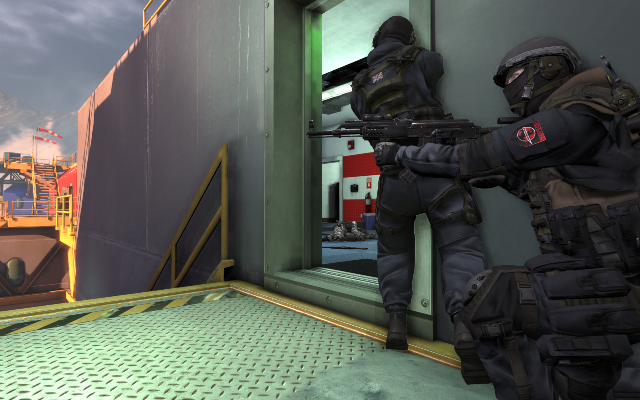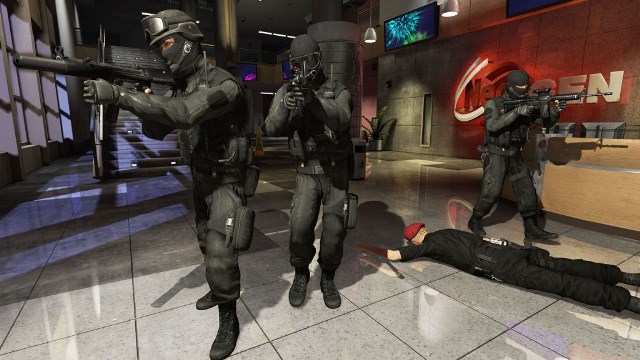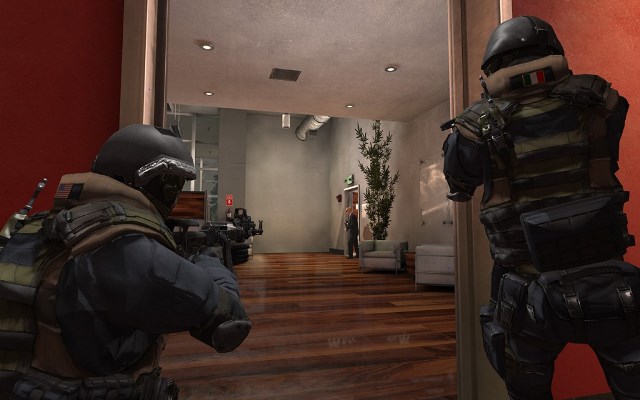Takedown: Red Sabre preview: This is your father’s Tom Clancy
He knows what he wants, Christian Allen does. He’s known since the start. Even before the start, actually. Before Takedown: Red Sabre’s 2012 Kickstarter campaign successfully raised over $200,000, Allen, creative director at indie development studio Serellan, knew he wanted to go back.
He wanted to take gamers back in time. Not too far, only a few years. Back to a time when “tactical” shooters felt more, well, tactical. They had realistic combat — or as close as video games of that could come to approximating it, at least. The Tom Clancy video games from early last decade didn’t play anything at all like the myriad Halo, Gears of War and Call of Duty releases that dominate today’s shooter market. Certainly there is nothing inherently wrong with the approaches those games’ developers have taken to creating an FPS. There is something wrong, though: most everyone else is trying to make the same games as them.
Not Allen and his team at Serellan. Allen knows what he wants, and it isn’t Halo or Call of Duty. Lucky for him, he seems to have a team that knows how to deliver it.
Being a team player
He estimates that the least amount of experience anyone at Serellan has is eight years. Each member of the team has shipped multiple shooters for multiple platforms. As for Allen, between 2002 and 2007 he worked for Tom Clancy factory Red Storm Entertainment on various titles in the Ghost Recon and Rainbow Six franchises — tactical shooters. I ask if that deep and varied shooter development background meant Takedown would feature a lot of different concepts.
“I wouldn’t say it’s about concepts, because we’ve had a really clear vision from day one about what we wanted gamers to experience,” Allen responds. “The great thing about the different devs is that we’ve all shipped at least a billion dollars in revenue of games and almost exclusively shooter titles. So I know, for example, our weapons artist, our character artist, our environment artist — they know how to build shooter levels and content that works, so I can really fire and forget.”
As we speak, we’re standing in a Los Angeles Convention Center conference room rented out by publisher 505 Games. It’s off of the Electronic Entertainment Expo show floor, meaning it’s far from the noise being generated by big-budget games such as Activision’s latest Call of Duty. This one has a dog in it. It also happens to be in the same booth as another of the big three shooters commanding so much attention at E3: Destiny, developed by none other than Halo’s creators over at Bungie.
Back in the conference room, Red Sabre: Takedown is tucked unassumingly enough into a corner of 505’s conference room. A couple of other members of the press have joined a pair of team members from Serellan in some co-op missions being played on four networked PCs. The first thing I notice about it is that it’s loud. It’s usually not this loud when you get away from the show floor. It’s not the game itself that’s making all the noise; it’s the players. The dev team is yelling out tactical jargon like, “Tango down!” and “I’m on your six!” in what feels like an attempt to sell the military authenticity Serellan is striving for as well as the teamwork Allen believes organically develops among players as a result of that realism.
The game was not built to develop teamwork, says Allen. He says that just happens. “Yeah, honestly we built the game system, and the teamwork comes out of that. We don’t do fake things. You know, some games, ‘Oh you’re gonna lose health bars if you’re away from your teammates, or if you’re close to your teammates you get bonus damage or you respawn on your teammates or things like that.
“We just built a highly lethal, non-linear space, and because it’s highly lethal and because there’s all those angles that you need to cover, people naturally fall into teamwork. Because if you run off by yourself, you’re not covering your back. There’s no radar. There’s no indication that someone’s behind you.”
When I get my hands on the keyboard and mouse, I don’t exactly feel compelled to yell out that there is a tango at 1 o’clock in the courtyard, and it feels a bit forced that the dev team is doing things like that. But then again, they’ve all had countless hours of experience doing this before. Maybe that sort of thing develops naturally over time. Maybe.
Modern amenities — forget about them
More immediately, playing slow and steady and watching each other’s backs does come naturally. Play like a gunslinger in Red Sabre: Takedown, and death will come swiftly. There is no respawning, either. Die once, and it’s game over until the next round. There’s been a lot of that the past two days, apparently — no one at E3, not even with the benefit of playing alongside two or three of the game’s developers, has beaten this mission yet.
Takedown: Red Sabre is nothing if not hard. It isn’t the type of hard that inspires fits of controller-throwing, yelling-at-the-TV anger, though. It’s the type of hard that makes the Defense Department regret to inform mothers that their sons are dead because they were stupid. When you’re not running, the game forces you to move at a snail’s pace, which can feel a bit annoying for those of us used to modern shooters, but moving slowly with purpose and precision is a prerequisite for staying alive in Red Sabre.
There is no radar. Death from a single bullet is always a threat. The screen does not light up red in the direction from which you’re being shot. There is locational sound, at least. “Obviously,” says Allen.
“And that’s one of the things I like about this game,” he says of his project. “When I was working on Halo: Reach I played, obviously, a lot of Halo. And I’m a pretty good gamer. I can kick ass and draw pretty good, but when I got into Halo I had a lot of cases — which I love the universe — but I had a lot of cases where I see a guy with his back to me, he’s an enemy, I start unloading on him, he, you know, does the whip around, 180 degrees, headshots me and then he’s off and running. I’m like, ‘Damn it! I totally got the drop on him, but I’m a level 11 and he’s a level 50, you know, right?’ Level 50 pwns everybody in Halo, hands down.”
There is no level 50 in Takedown: Red Sabre. There are no levels one through 49, either. The game’s Kickstarter backers didn’t want a leveling-up system, so Serellan didn’t create one. Allen says the backers, from whom a — and Allen’s careful to explain that this isn’t a precise percentage — “**** ton” of feedback has made it into the game, wanted access to all the game’s weapons, attachments and ammo types right from the start. Serellan is giving it to them, and anyone else who picks up its game.
Choose wisely…or else
“We give you the information, and then you choose,” Allen explains. “Made a bad choice? Well, you’re screwed. You can still kill enemies, take their weapons, things like that, but what [the Kickstarter backers] don’t want is — they want an even playing field based on your skill, your thought, your tactics, your teamwork, versus, ‘Hey, I’ve played 10 more hours than you, so my gun is 10 times better than yours, and you’re never going to beat me.’”
The weapon/attachment/ammo selection system isn’t on display at E3, but that doesn’t stop me from getting “screwed.” Midway through one attempted mission, our group moves at what feels like millimeters at a time, checking every angle as we approach a door leading out from a two-floor building and into a courtyard. Senior Producer James Mayo warns that there are tangos waiting for us. I take point and head outside to crouch behind a dumpster. Approximately three seconds later I’m sitting back and watching as the dev team plays without me. The bad guys were over to the left near another building, waiting for someone to screw himself.
We’ll get them next time.
Next time comes and two of the members of the dev team are gunned down before the group can manage to make its way to the house. Following instructions from the only dev still in the game, I “Kill the guy in the white suit” when the dev opens a door on the second floor. No, actually, that doesn’t happen at all. The bullets narrowly miss the suited-up bad guy. Panic sets in and the subsequent shots go even farther astray thanks to the gun’s kickback. White-suit guy takes advantage of his Pulp Fiction-esque luck and shoots. Now the door-opening developer is playing by himself.
Four or five more attempts to complete a mission also end in defeat. The dev team’s earlier claim that no one had beaten the level yet now seems plausible. The challenge isn’t detracting from the fun, however. We take our fair share of bad guys down with us on each attempt. There’s a certain thrill involved knowing that if you see them and don’t fire first and fire true, you’re probably getting killed.
On occasions when our bullets do strike first, the bad guys tend to go down in awkward fashion, contorting their legs in a manner that resembles some sort of cross between the movements of a thin man from Xcom: Enemy Unknown and Octodad. It’s peculiar.
If these walls could talk
For the most part, though, Takedown: Red Sabre is as real as it gets. “We’ve got bullet penetration throughout the levels,” Allen says in the minutes leading up to our play session, “so based on every material in the game a bullet has a penetration value, so it can shoot through certain things.” He goes on to explain that there are wooden panels that won’t be saving anyone standing behind them from rifle rounds, whereas concrete surfaces do a far better job of offering cover.
Testing it out a few moments later, I let loose some rounds into a wooden panel some bad guys have run behind. They don’t run back out again. They don’t run anywhere ever again, for that matter.
There’s more to the system than just wood vs. concrete. Every surface in the game has different penetration values, and Allen says that “it also calculates the depth of the surface, so if you have like a 13-foot [deep] thing and you try to shoot through it, yeah, it’s not going to shoot through it. And it also actually calculates multiple surfaces. So if you have multiple wood panels it keeps going until it hits like panel three, and then it stops.”
Allen is a former marine who holds a Federal Firearms License. He’s a self-proclaimed “gun nut.” He explains that while some numbers research did go into the penetration calculations, they’ve mostly been made based on a “subtle kind of influence where I know a jacketed hollow point has less penetration but more hydrostatic damage, whereas an [armor-piercing] round is going to punch through armor, but it leaves a small hole.”
For those times when players aren’t behind 13-foot-deep concrete walls, Allen and company have also created a wounding system. “Every round has a chance of wounding you and killing you, no matter what the round,” he says, “and that’s based on the round, the penetration value, what armor you take and then factors like… if you’ve been wounded before there’s a higher chance of killing you.”
There are no hit points, overshields or regenerating health bars. It is possible to survive being shot once or twice in a limb, but players won’t simply shrug it off and keep on trucking. “Once you get shot you’re wounded, your accuracy suffers. If you get shot in the leg, you’re not going to be able to sprint,” warns Allen. “If you’re wounded, you just gotta slow down and be more careful.”
Getting shot at all is ill-advised. So you’ll stick behind cover, then. Don’t think you can run right up flush against concrete bastions, however. You can do that in most every modern shooter ever made. It doesn’t make much sense. Where does your gun go when your face is inches away from a wall? Magic? Most developers don’t deem answering that question a worthwhile use of their development time. Serellan did.
“For example, our peek-and-lean system — a lot of games these days they have a cover system where you come up and stick to the wall,” Allen says. “Because we’re on Unreal Engine 3 that system actually comes with the engine, and our AI actually uses it, so the enemy AI, it sticks to the wall and things like that. Players of this type of game, they don’t like that, because when you go into third-person when you’re against a wall you can go into third-person to use the camera to look around the corners.
“So what they wanted is more of a peek-and-lean , so we incorporated that, but we also have weapon-down collision. So, based on the length of your weapon, when you come up to a wall you have to put your weapon down. You can’t come up to a wall and do any of this magic stuff [at this point he walks straight into a wall with an imaginary rifle held straight out at a 90-degree angle from his body]. You take a big, long weapon — and we have a customization system where you can put a suppressor on the end — now you take a two-foot-long weapon, you’re going around the level and it’s banging into stuff sometimes, whereas you take a nice submachine gun, and you can peek.”
He’s decidedly proud of Takedown: Red Sabre’s various systems. He and his team of industry vets have brought them together to build something that is inarguably different than most shooters you’d find lining the shelves at the local GameStop.
Stop, aim, shoot
Takedown: Red Sabre isn’t a twitch shooter, and that’s what Allen likes about it. “If you stop and you aim and you shoot, that beats being a twitch gamer that’s super hot on the controls.”
So it’s more about tactics and thinking ahead?
“Yeah, exactly.”

